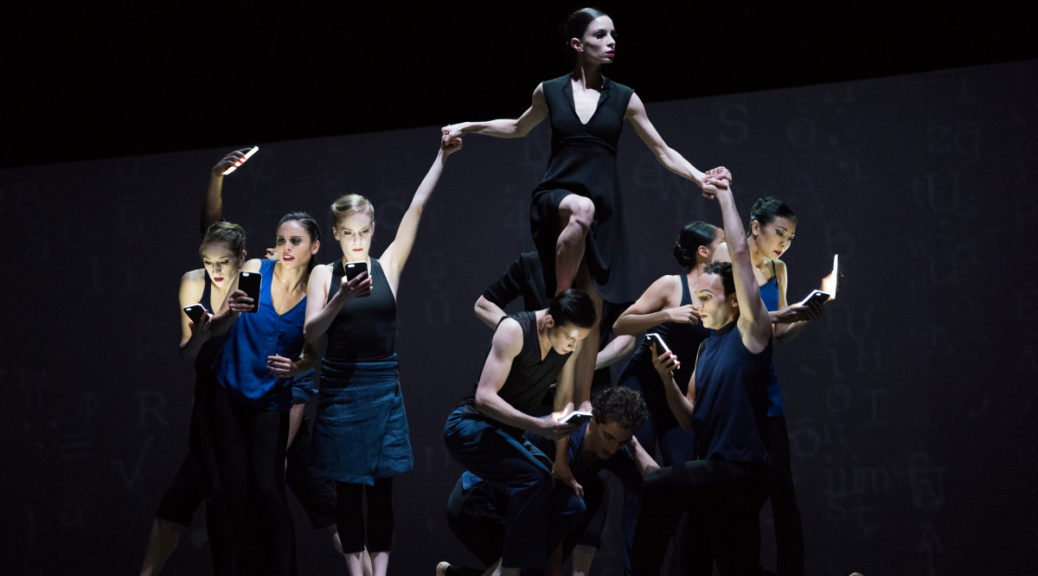
BOUND TO OUR SMARTPHONES, SAYS WHEELDON IN DANCE
Choreographer Christopher Wheeldon took on our smartphone mesmerization in his new social-critique ballet, “Bound to…” It was a memorable shot across the bow leading off the S.F. Ballet’s supremely ambitious “Unbound” festival of 12 premieres by choreographers still under 50, all unveiled in about a week. Ballet pointe shoes were put aside in favor of sporty flats.
“Bound to…” To what? Bound to our cell phones of course, as we wander about staring at our hand-helds, oblivious to all the life around us. And when an unaddicted woman (Dores André) seeks contact with one of them, it’s hopeless, like trying to climb over the Mexican wall.
The message was clear in Wheeldon’s timely piece: Wake up and smell the roses. And maybe communicate with one another, too—It’s not fatal!
The inventive Wheeldon is quirky, using the genders interchangeably, with novel touches. Males engage in chummy embraces,while two women in a pas de deux forego high-fives in favor of sole-to-sole contact—maybe soul-to-soul as well. Designer James F. Ingalls provides a waterfall of computer words and letters (much like the film “A Beautiful Mind”) in a setting that is as gray as the smartphone environment, where nebulous silhouettes dash by in colorless anonymity. Of course electronic music predominates.
Justin Peck’s “Hurry Up, We’re Dreaming” could have been inspired by Berkeley’s Summer of Love, 1968, with highly varied colorful costumes, and the high-energy dancers seen as if from backstage in their revelries. Three couples predominate, headed up by the ladies André, Sarah van Patten and the fast-rising, animated Mexican plucked from the corps de ballet, Gabriela Gonzalez. The various pas de deux featured animated twists and turns. The Peck brainstorms also featured an automaton, and a rare brief instance of affection shown between paired dancers.
The “Unbound” festival is intended to show which way ballet is headed, via 12 of the top international mid-career creative artists. But all too often in modern ballets, night after night you get feats of speed and strength, meticulously mastered, with abstraction, in one work after the other, regardless of what US-based ballet troupe you are seeing. Is modern ballet forgetting its roots and turning into a glorified phys-ed display? Where are the feelings and character interactions that bring theater and drama into the fray? I get more emotion out of a track meet than from a typical modern-ballet night.
We don’t need whole seasons of fairy tales and enchanted swans, as 150 years ago. But the post-Balanchine pendulum has swung far into the opposite direction, as if in squeaky-clean gymnastics championships. Why can’t the pendulum swing back and forth countless times, bringing out the optimum versatility of the meticulously trained ballet dancer having emotion and three-dimensionality?
The “Unbound A” program viewed April 22 opened with Alonzo King’s “Collective Agreement,” the only piece on pointe (even though King is best known for his work with his modern dancetroupe Lines). A pair of corps dancers (Jahna Frantziskonis, Joseph Warton) were featured along with principals Sofiane Sylve and Tiit Helimets. There were unfamiliar moves and much stretching, and a lot of stiff, straight-knee locks that were more curious than engrossing.
All in all, “Unbound A” showed off the immense depth of the SFB and the admirable training behind it. The novel ideas and approaches of Peck, 30, and Wheeldon, 45, showed off a wealth of choreographic ideas as embodied by the cream of today’s crop.
“Unbound A” festival program of 12 new works, April 20-May 6, by San Francisco Ballet, with B, C and D pending. Opera House, S.F. For info: (415) 865-2000, or go online.